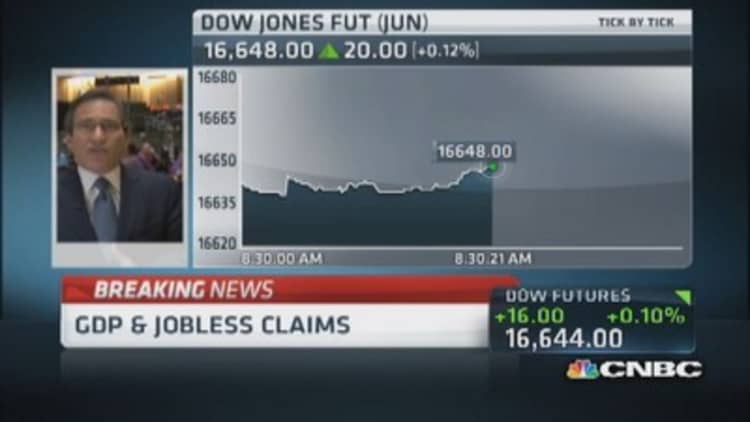
The U.S. economy contracted in the first quarter for the first time in three years as it buckled under the weight of a severe winter, but there are signs activity has since rebounded.
The Commerce Department on Thursday revised down its growth estimate to show gross domestic product shrinking at a 1.0 annual rate.
Read MorePending home sales up just 0.4% in April
It was the worst performance since the first quarter of 2011 and reflected a far slower pace of inventory accumulation and a bigger than previously estimated trade deficit.
The government had previously estimated GDP growth expanding at a 0.1 percent rate. It is not unusual for the government to make sharp revisions to GDP numbers as it does not have complete data when it makes its initial estimates.
The decline in output, which also reflected a plunge in business spending on nonresidential structures, was sharper than Wall Street's expectations. Economists had expected the revision to show GDP contracting at a 0.5 percent rate.
The economy grew at a 2.6 percent pace in the fourth quarter. U.S. financial markets are likely to shrug off the report, given the temporary factors that weighed down on growth and the fact that economic activity is rebounding.
Data ranging from employment to manufacturing suggests growth will accelerate sharply in the second quarter.
Read MoreFed's Lockhart: No rush to raise interest rates
Economists estimate severe weather could have chopped off as much as 1.5 percentage points from GDP growth. The government, however, gave no details on the impact of the weather.
Businesses accumulated $49.0 billion worth of inventories, far less than the $87.4 billion estimated last month.

It was the smallest amount in a year and left inventories subtracting 1.62 percentage points from first-quarter growth. But inventories should be a boost to second-quarter growth.
While the decline in exports was not as severe as initially thought, import growth was stronger. That resulted in a trade deficit that sliced off 0.95 percentage point from GDP growth.
A measure of domestic demand that strips out exports and inventories expanded at a 1.6 percent rate, rather than a 1.5 percent rate, indicating underlying strength in the economy.
Consumer spending, which accounts for more than two-thirds of U.S. economic activity, increased at a 3.1 percent rate. It was previously reported to have advanced at a 3.0 percent pace.
Spending was boosted by the Affordable Healthcare Act, which expanded healthcare coverage to many Americans. Consumer spending had increased at a brisk 3.3 percent pace in the fourth quarter.
Business spending on nonresidential structures, such as gas drilling, contracted at a 7.5 percent rate. It had previously been reported to have increased at a 0.2 percent pace. The report showed corporate profits after tax plunged at a 13.7 percent rate, the biggest drop since the fourth quarter of 2008.
A separate report showed the number of Americans filing new claims for unemployment benefits fell more than expected last week, pointing to a strengthening labor market. Initial claims for state unemployment benefits declined 27,000 to a seasonally adjusted 300,000 for the week ended May 24, the Labor Department said.
The prior week's claims were revised to show 1,000 more applications received than previously reported. Economists polled by Reuters had forecast first-time applications for jobless aid falling to 318,000 last week.
Claims have been choppy in recent weeks, reflecting difficulties seasonally adjusting the data around moving holidays such as Easter and Passover. Through the volatility, however, claims continued to suggest the labor market was firming.
Read MoreWhere US manufacturing jobs are growing
The four-week moving average for new claims, considered a better measure of underlying labor market conditions as it irons out week-to-week volatility, fell 11,250 to 311,500 last week, the lowest level since August 2007. A Labor Department analyst said there were no special factors influencing the state level data.
The claims report showed the number of people still receiving benefits after an initial week of aid fell 17,000 to 2.63 million in the week ended May 17, the lowest level since November 2007.
That covered the household survey week, from which the unemployment rate will be calculated.
The unemployment rate of people receiving jobless benefits was unchanged at 2 percent. That and a 43,000 decline in the so-called continuing claims between the April and May survey periods suggest the unemployment rate could decline from 6.3 percent in April.
CORRECTION: This story has been updated to reflect a corrected headline GDP figure.
—By Reuters

